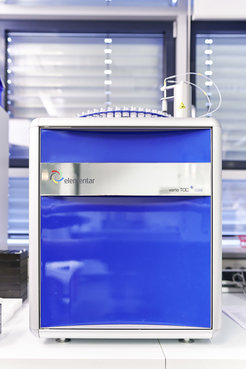
Sum parameter analysis
We use sum parameter analysis in our laboratory to measure dissolved carbon and nitrogen compounds. These are detected in surface and soil waters, but also in various solid extracts. As a substance group with the same or similar properties combined in one measured value, we determine, for example, the total carbon (TC), the total organically bound carbon (TOC) and the total bound nitrogen (TNb). By burning a portion of the liquid sample at temperatures above 800 °C, the carbon and nitrogen compounds are released in the form of CO2 and NOx. The proportions of the required sum parameters in the sample are recorded by detecting the gases produced.
Depending on the instrument and sample type, the samples must be additionally diluted and/or acidified before measurement. If, by definition, the dissolved organic carbon (DOC) or the dissolved nitrogen (DN) is to be recorded, a 0.45 µm membrane filtration of the sample material is required before analysis in order to exclude particulate-bound carbon and nitrogen compounds. For measurement, the appropriately prepared sample is transferred into a sample vial and placed on the autosampler of the meter. An aliquot of the liquid sample is injected into a combustion tube filled with catalyst and burnt in a high-temperature process in the presence of oxygen.
The analysis of the dissolved carbon compounds is based on the separation of the inorganically and organically bound carbon and the subsequent determination of the resulting carbon dioxide (CO2) in the infrared detector. By acidifying the sample with a non-oxidising mineral acid to a pH value < 2, the dissolved carbonates and hydrogen carbonates (TIC) are converted into CO2. The organically bound carbon (TOC) is also converted into CO2 by high-temperature combustion. Depending on the instrument and the scientific question, it is possible to determine the TOC by using the differential or the direct method.
The difference method records the total carbon (TC) by means of combustion and the inorganically bound carbon (TIC) after acidifying a sample aliquot and stripping out the resulting CO2. The organically bound carbon (TOC) is then calculated as the difference: TOC = TC - TIC.
The direct method records the organically bound carbon after combustion. For this purpose, the acidified and stripped sample, which now no longer contains inorganically bound carbon, is applied to the catalyst and burnt in a high-temperature process. The measured value obtained is the non-purgeable organic carbon (NPOC). Ideally, the NPOC is equal to the TOC, and this is the case when no volatile organic compounds (VOC) were contained in the sample.
To measure the dissolved nitrogen compounds (TNb, DN), we also use high-temperature catalytic combustion. An aliquot of the liquid sample is burnt at 800 °C in pure oxygen. The oxygen also serves as a carrier gas. All bound nitrogen compounds in the sample are oxidised to nitrogen oxides (NOX) and subsequently converted to nitrogen monoxide (NO). The NO gas is then mixed with ozone, converted into energetically excited NO2 and measured in the chemiluminescence detector. The intensity of the emitted light is proportional to the original NO concentration over a wide range. For quantification, the emitted photons are optically recorded, counted using a photomultiplier and mathematically evaluated in the form of a peak.
To ensure the highest accuracy and precision of our measurements, the measuring instruments are regularly maintained and checked daily. In each newly started measurement sequence, chemical standards and certified reference materials are analysed before the samples are measured to prove the quality of the measurements.

Elementar Analysensysteme GmbH,
Elementar-Straße 1, D-63505 Langenselbold, Germany
Parameters vario TOC cube
- Analyts: TIC (DIC), TOC (DOC) as NPOC
- Sample material: water samples & extracts
- Sample volume: 10 mL
- Sample preparation: 0,45 µm membran filtration for DIC, DOC

Parameters TN-100
- Analyts: TNb, DN
- Sample material: water samples & extracts
- Sample volume: 4 mL
The exact quantification of carbon and nitrogen compounds is used to research the effects of land use, management and biodiversity on the elemental balance.
Investigations of this kind also provide insight into the variability of organically and inorganically bound carbon in the soil, and how these elemental stocks can be influenced at regional and global levels. The nitrogen content provides information on various substance groups and the microbial degradability of the organic material.











